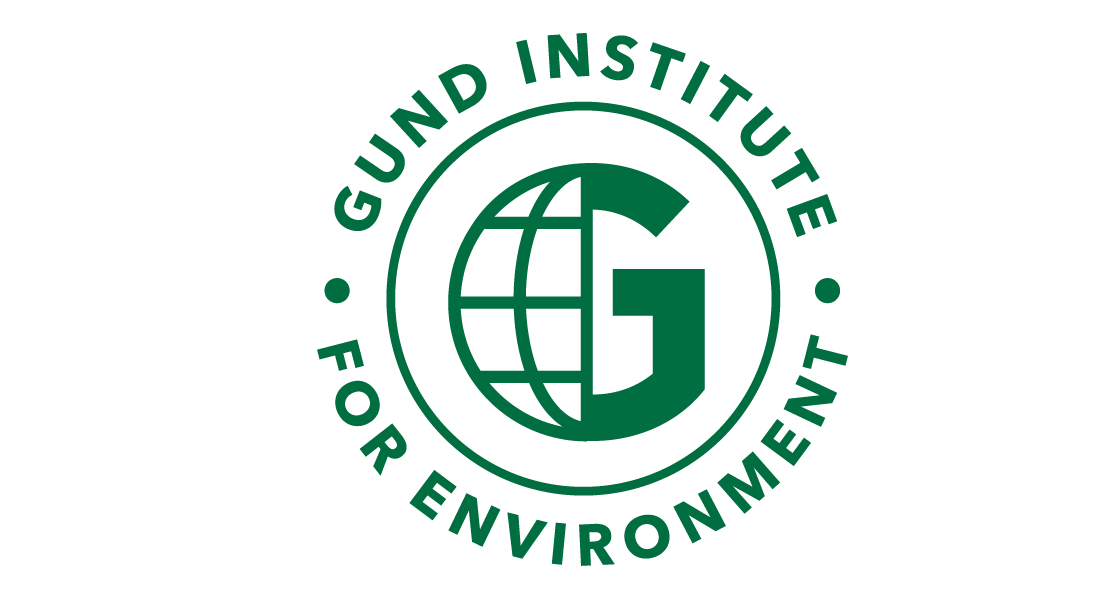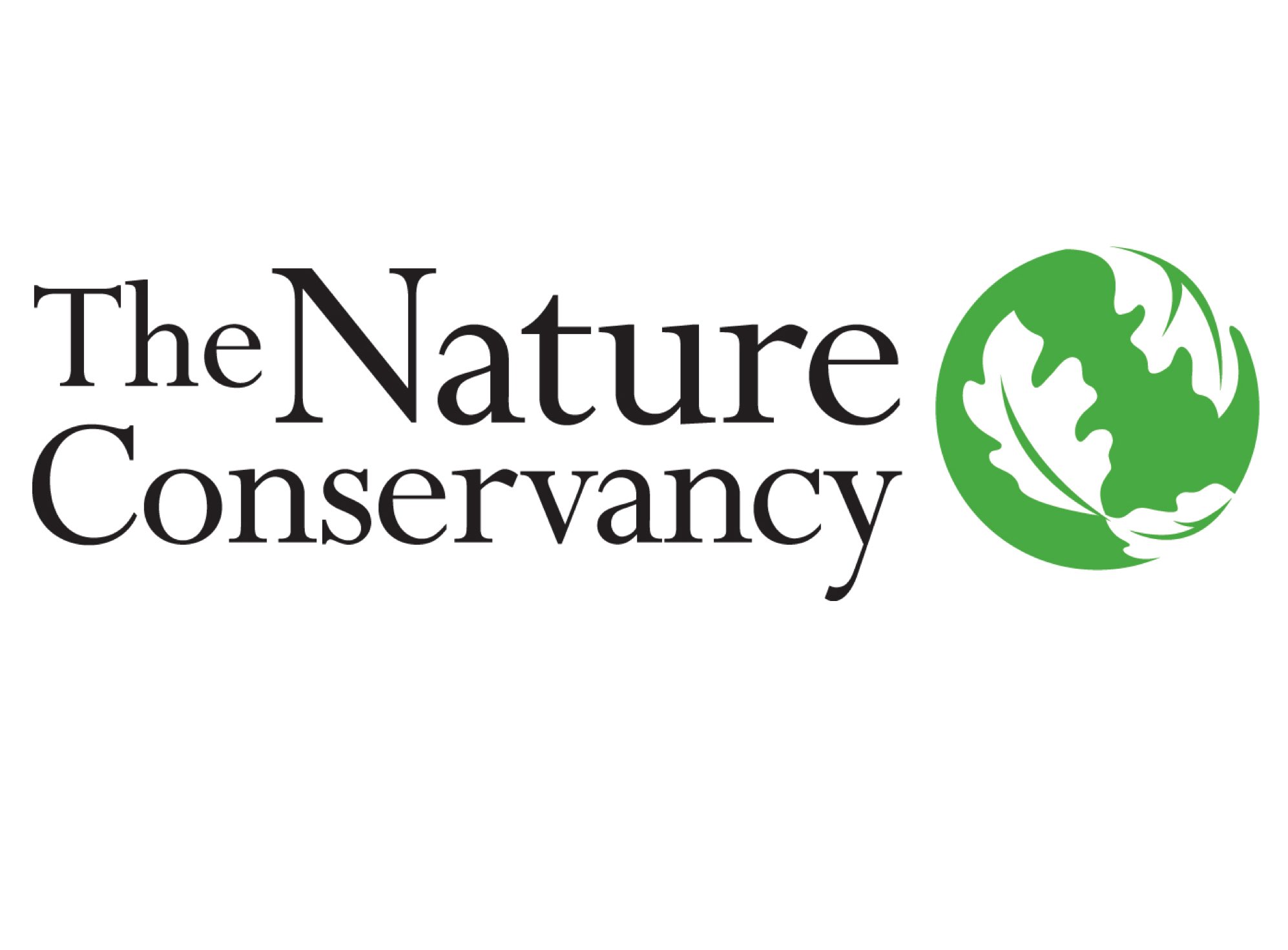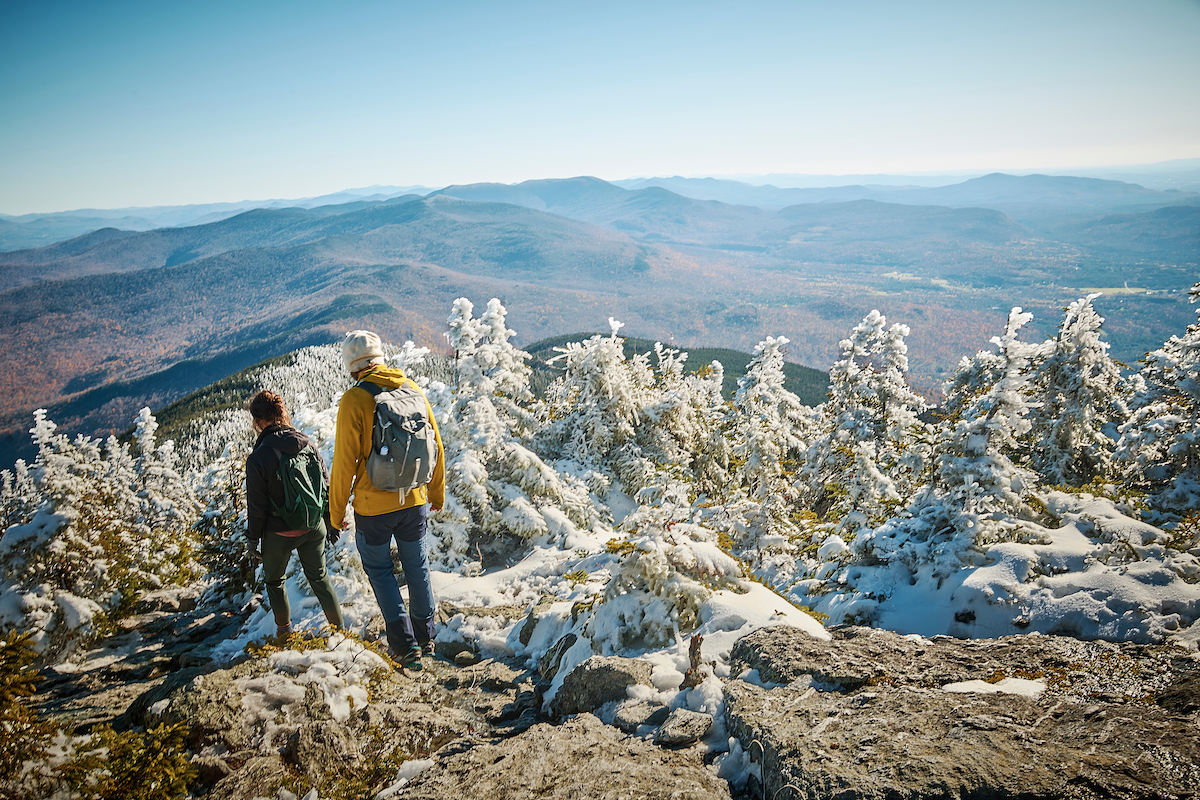
Recreation and Tourism
Download chapter PDF and figures
Authors
Franni Hoag
Rubenstein School of Environment and Natural Resources and Gund Institute for Environment, University of Vermont, Burlington, Vermont 05405
Sarah T. Raimondi
Rubenstein School of Environment and Natural Resources and Gund Institute for Environment, University of Vermont, Burlington, Vermont 05405
Daphne D. Zencey
Rubenstein School of Environment and Natural Resources and Gund Institute for Environment, University of Vermont, Burlington, Vermont 05405
Citation
Hoag, F., Raimondi, S., Zencey, D., 2021. Recreation and Tourism. In Galford, G.L., Faulkner, J. et al. (Eds), The Vermont Climate Assessment 2021. Burlington, Vermont: Gund Institute for Environment at the University of Vermont. DOI: 10.18125/kowgvg.
Table of Contents
- 7.1 Key Messages
- 7.2 Introduction
- 7.3 Winter
- 7.4 Summer
- 7.5 Shoulder Seasons: Fall and Spring
- 7.6 Conclusions
- 7.7 Acknowledgements
- 7.8 References
7.1 Key Messages
Winter
- Downhill skiing, with the help of snowmaking, will likely remain largely viable in Vermont up until approximately 2050. By 2080, the Vermont ski season will be shortened by two weeks (under a low emissions scenario) or by a whole month (under a high emissions scenario), and some ski areas will remain viable.
- Winter temperatures are increasing in Vermont, reducing the length of season for most snow sports.
- February Median Flow, a measurement used by ski areas to collect water for snowmaking, has steadily increased across Vermont.
Summer
- Summer recreation activities in Vermont will continue to be popular, with water-based activities likely to increase in interest as air temperatures rise. However, water quality issues will also become more prevalent.
- Vermont may see an increase in summer “seasonal climate refugees” as the rise in temperatures nationwide draws visitors looking to escape extreme heat.
- Vermont has the potential to increase tourism revenue via gastrotourism and agritourism as the growing seasons lengthen.
Fall/Spring
- Transition seasons are becoming more important for tourism and recreation as Vermont is already experiencing warmer temperatures in fall and spring.
- Trees, particularly sugar maples, are an important aspect of many fall/spring recreation activities (leaf peeping, maple syrup, apple picking), but may be negatively affected by warmer temperatures.
- Fall and spring seasons offer new opportunities for lower-cost recreation and tourism opportunities that attract a wider range of potential visitors.
7.2 Introduction
As stated in the 2014 Vermont Climate Assessment (VCA), “Recreation and Tourism go together in Vermont.” Vermont’s rich and mountainous settings and its cooling lakes and streams offer opportunities for a wide variety of recreational activities across the seasons, drawing visitors from all over the country and internationally. With the exception of the year 2020, which was ravaged by the COVID-19 pandemic, the Vermont tourism industry generates nearly $3.0 billion a year (Vermont Agency of Commerce and Community Development, 2021), making recreation and tourism one of the most lucrative industries in the state. Outdoor recreation, as a top driver of Vermont’s economy, offers the potential for a wide variety of satisfying careers, thus encouraging college graduates and other young people to remain in Vermont and drawing others to the state.
Currently, Vermont tourists mainly come from the Northeastern states (Vermont Department of Tourism and Marketing, 2018), but with climate change leading to elevated temperatures, Vermont may see an increase in visitors from other areas looking to escape the extreme summer heat. Likewise, as global temperatures increase, Vermont’s transitional seasons of spring and fall are expected to lengthen as rising temperatures result in shortened winter overall (see Climate Change in Vermont chapter). Given the seasonality of most of Vermont’s outdoor recreation opportunities, climate change is likely to affect each recreation-based sector in a unique and challenging way. The Vermont ski industry will need to adjust to new snowmaking requirements, syrup makers will be forced to tap maples earlier, and hiking trails will degrade more quickly due to extended hiking seasons and/or increased erosion. It is undeniable, however, that climate change will have lasting effects on the way Vermonters and tourists recreate.
Recreation activities and tourism opportunities in Vermont range from high-priced to free, with seasonal variation. Participation also varies across socioeconomic and demographic categories. Some sports and outdoor activities (skiing, boating, snowmobiling) tend to be more exclusive: they draw a wealthier group of participants because of the costs associated with participation. Other activities (more likely to be those in the spring, summer, and fall seasons) are lower in cost or even free: sightseeing, hiking, walking for pleasure, birdwatching, fishing, and other group and individual activities. Decades of recreation research have shown that racial demographic groups are differentially represented in outdoor recreation, sports, and tourism activities, and this is also true in Vermont, where the state population is reported to be about 94 percent white (US Census Bureau, 2019). The effects of climate change may have implications for this lack of diversity, however, as more out-of-state visitors from more diverse parts of the country (Mid-Atlantic and Central regions, for instance) may be drawn to Vermont, especially during longer summer and shoulder seasons. More climate change refugees may also see Vermont as a haven for new residences. In short, climate change offers Vermont new opportunities to diversify and offers new challenges to become a more inclusive state.
For the purpose of the 2020 Vermont Climate Assessment, the effects of climate change on Vermont’s recreation sectors will be identified based on the predominant recreation seasons: winter and summer are each discussed individually below, with fall and spring combined given the similarities in recreation opportunities for the two transitional seasons.
Box 7.1: COVID-19 and Recreation in Vermont
According to the Vermont Department of Forests, Parks and Recreation, the most important outdoor recreation issue in 2020 was an increase in outdoor participation. Given restrictions enacted during the COVID-19 pandemic, more Vermonters sought outdoor experiences and new outdoor activities. There was a noticeable increase in trail user days for hiking and mountain biking; Nordic and backcountry skiing surged; the number of hunting and fishing licenses issued increased; campgrounds were at capacity; and a myriad of other activities done for the sole purpose of spending time outside all had a rise in participation. These types of recreation opportunities have in turn lead to greater economic opportunities for outdoor-related businesses that provide gear and equipment, information about trail networks or camping sites, and skill-building education. Increasing numbers of recreationists has also driven patronage to businesses in the more rural communities and outer regions of the state, increasing revenue for these types of business statewide (VOREC, 2020).
Despite this surge in recreation users, money spent on traditional aspects of Vermont’s recreation and tourism industry—such as lodging, meals, and alcohol—plummeted by over $300 million (see Figure 7-1). It is impossible to know what the coming years will hold, but outdoor recreation provides a healthy outlet for people to cope with the dramatically changed times (Landry et al., 2021).
So while Vermont saw a decline in recreation and tourism revenue due to the COVID-19 pandemic, there was in fact a steady increase in people getting outside and recreating (VOREC, 2020).
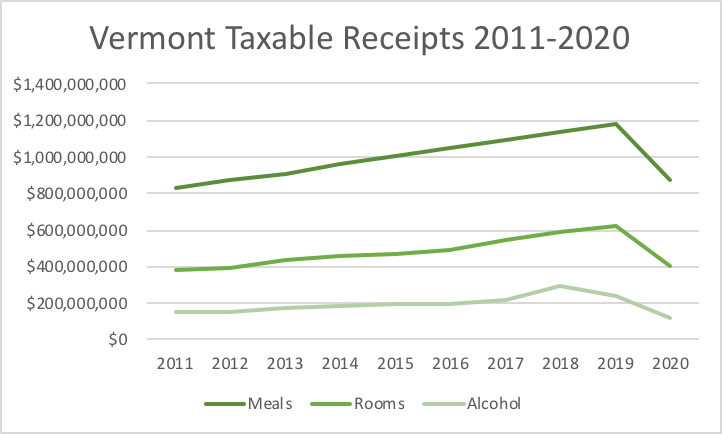
7.3 Winter
Winter recreation is an integral part of Vermont’s identity as well as a significant money-maker for the state economy (Vermont Department of Tourism and Marketing, 2018). Yet Vermont’s traditional winter season will certainly be shortened due to climate change. Despite this, skiing – which attracts millions of tourists to the state each year – will most likely be viable through nearly the end of the century. Winter sports that generate less revenue than skiing and that have fewer options for climate change mitigation, such as snowmobiling and pond hockey, will be particularly vulnerable to warming temperatures and variable precipitation in the coming decades. Nordic skiing may be able to maintain the length of its season by implementing creative snow preservation tactics, but an adequate amount of snow will have to fall and be collected.
Winter precipitation in Vermont has increased over the past century. Snowfall, an integral aspect of many winter recreational activities, peaked in the 1960s and 1970s and has declined since, especially in southern Vermont (see Climate Change in Vermont chapter). In one New Hampshire study, the “backyard hypothesis,” which states that urban skiers are more likely to head to the mountains on days that they see snow in their own backyards, was proven to be true (Hamilton et al., 2007). If Vermont continues to receive adequate amounts of snow, or if resorts can make enough snow to operate ski mountains, increasingly strong marketing campaigns will be needed to draw visitors from states with less regular or productive snowfalls.
Along with precipitation, temperature is also predicted to increase over the next century in Vermont (see Climate Change in Vermont chapter). If temperatures generally remain under 32 degrees Fahrenheit, this could mean an increase in annual snowfall. Average winter temperatures in Vermont are generally well below 32 degrees Fahrenheit (see Figures 7-2, 7-3, 7-4) but have steadily increased by roughly 3.3 degrees Fahrenheit since the early 1900s.Winter temperature variability also is significant, as temperatures may range more widely during the winter season (see Climate Change in Vermont chapter).
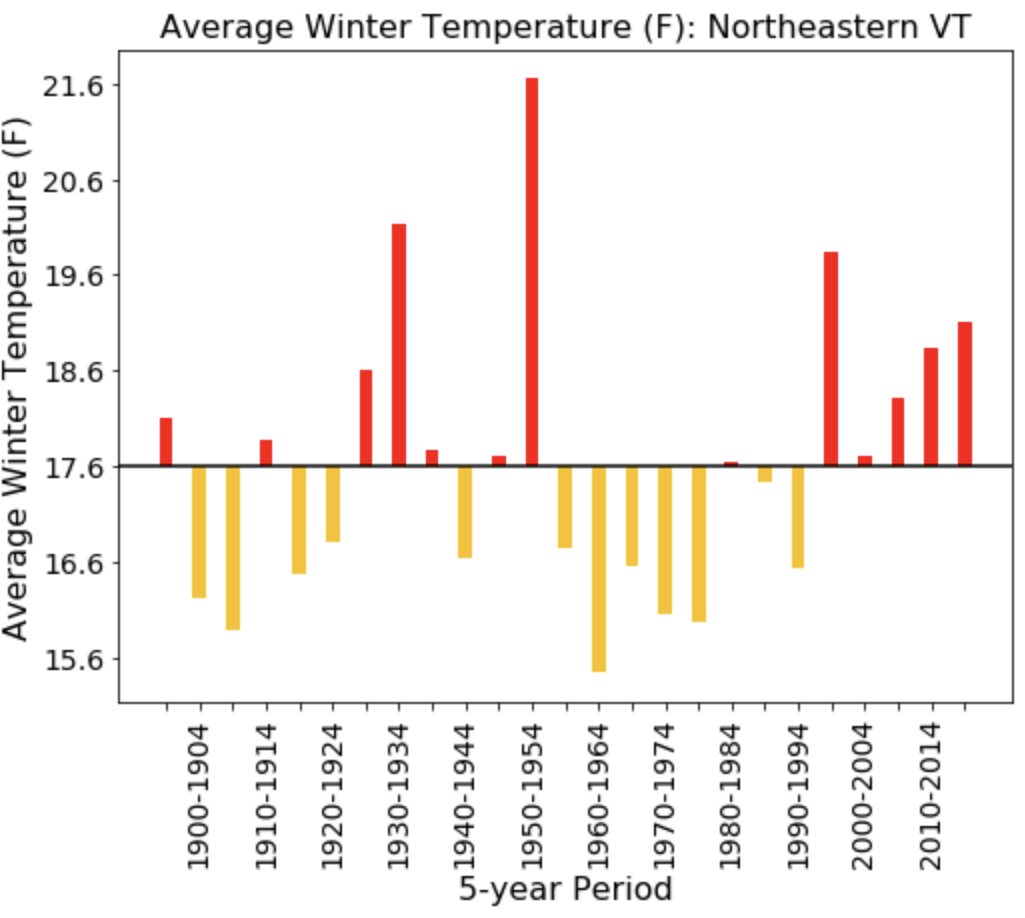
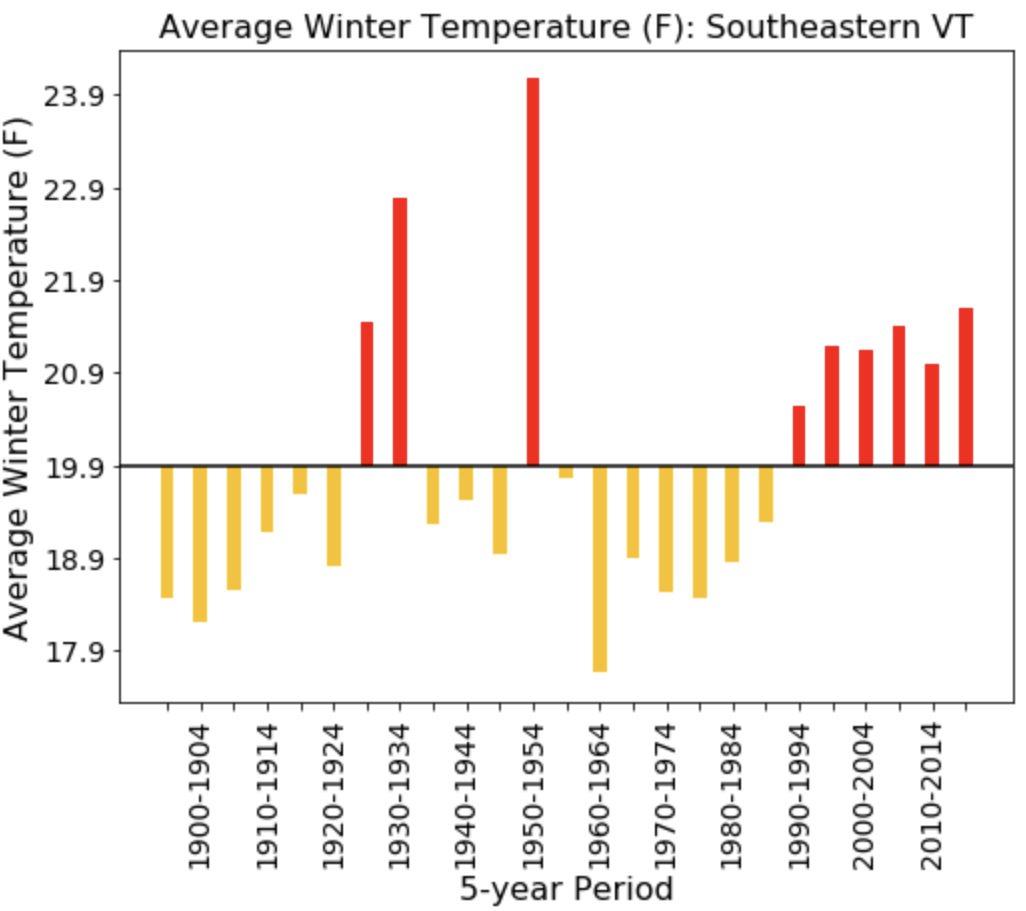
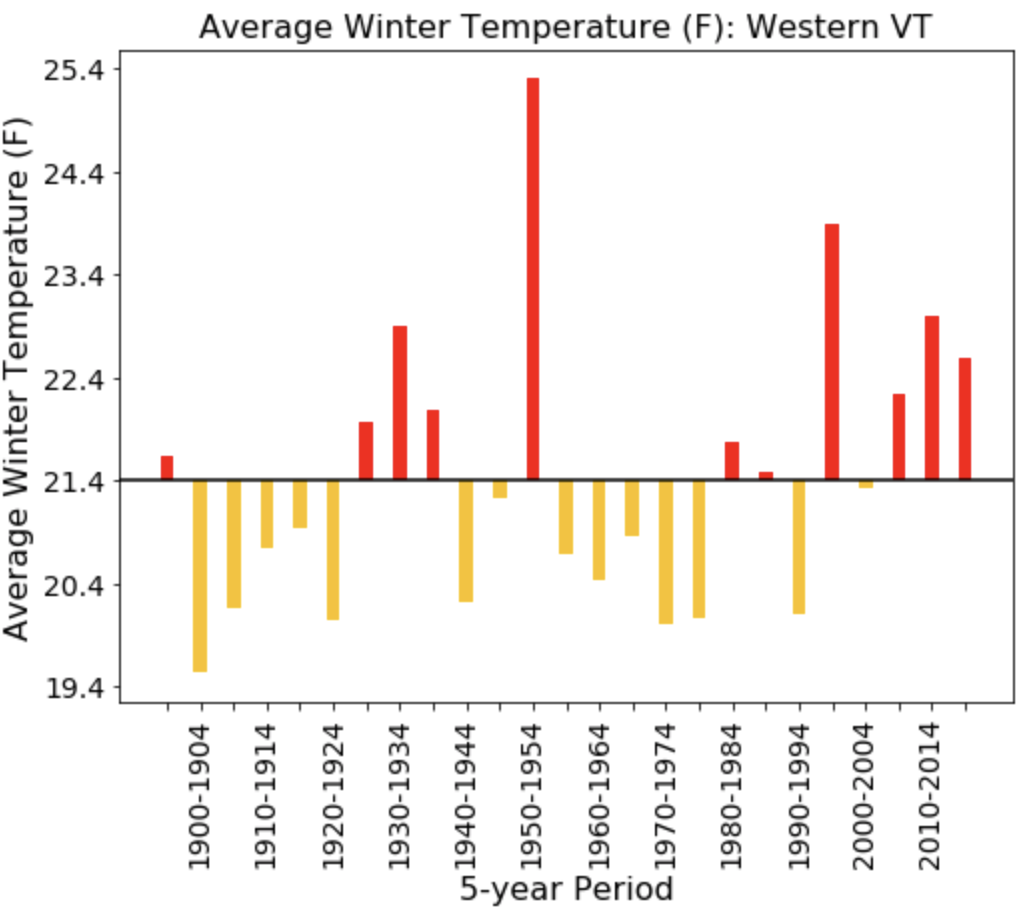
Temperatures must remain at or under 28 degrees Fahrenheit for ski areas to make snow (Bark et al., 2010). If the window of time when air temperature is at or below 28 degrees continues to shrink, snowmaking capabilities will be limited. For example, one 2018 study in the White Mountains of New Hampshire found a decrease in snowmaking opportunities in the early ski season and a projected further decrease in optimal snowmaking weather in decades to come (Wilson et al., 2018). The annual average air temperature in the White Mountain region of New Hampshire has increased by 1.8 degrees Fahrenheit since 1960 (Campbell et al., 2010). Vermont has been warming at a similar pace, with an average winter temperature increase of 3.3 degrees Fahrenheit (see Climate Change in Vermont chapter). This increase in temperature will likely be an especially serious issue where warming trends are most acutely present, as in southeastern Vermont (see Climate Change in Vermont chapter).
Through 2050, almost all ski areas in Vermont should be able to operate and contribute tourism dollars to the Vermont economy (Steiger et al. 2019; Scott et al., 2020)—and many will likely continue to operate as late as 2080 (Scott et al., 2020). Despite this, smaller ski areas at lower elevations, such as Suicide Six in Pomfret and Cochrans ski area in Richmond, will be faced with the most pressing climate-change challenges in the coming decades, as warming trends are predicted to continue (VCA, 2014).
Vermont snowmakers wishing to make snow must adhere to the water withdrawal laws outlined by Chapter 16 of the Vermont Agency of Natural Resources Environmental Protection Rules. This law essentially states that ski areas may only withdraw water from a stream until it reaches its February Median Flow levels (Shanley & Wemple, 2001). February Median Flow is an average of the median stream flow rate for every single day of February. Because stream flow is at its lowest point in February, the State of Vermont feels that withdrawing water beyond the point of February Median Flow would disrupt stream ecosystems and should therefore not be allowed. Figure 7-5 shows an increase in February Median Flow since the year 1960 – an increase that is consistent with overall streamflow increases over the past century in Vermont (see Water Resources chapter). This observed streamflow increase can most likely be attributed to loss of snowpack and early snowmelt during February as well as increased winter precipitation (see Water Resources and Climate Change in Vermont chapters).
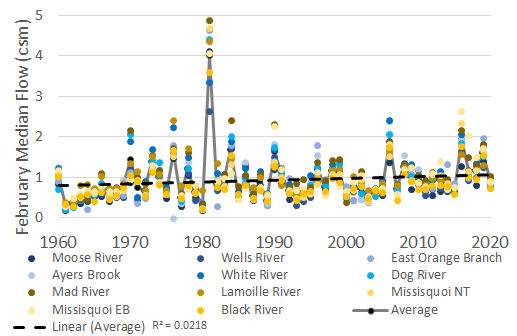
Source: Water Resources Chapter, data from USGS and Water Resources Chapter, data collected from the USGS streamflow database.
Although the Vermont ski season is certainly vulnerable to climate change, the state has been included in some promising projections. In one snow reliability study, all researched northeastern US states other than Vermont were projected to lose at least half of their ski areas by the mid-2050s under a high emissions scenario (Steiger et al., 2019). Skiing in Vermont is projected to be economically feasible at most resorts until about 2080 (Scott et al., 2020). Vermont could potentially capitalize on this resiliency and may see increasing demand for skiing and related winter activities through mid-century. To effectively capture this market, Vermont ski areas would have to meet the 100-day and Christmas holiday indicators. The 100-day indicator states that a ski resort must have snow coverage of at least 30 centimeters, for seven out of ten winters, during the 100 day period between December 1 and April 15th (Bürki, 2000 and Steiger & Abegg, 2013). The Christmas holiday indicator (covering the Christmas and New Year’s holiday period) focuses on the likelihood of a ski area having a snow depth of at least 30 centimeters between December 22 and January 2 (Scott et al., 2008). Snow coverage of 30 centimeters to 50 centimeters (12 to 20 inches) is needed for skiers and riders to recreate on the mountain safely (Bürki, 2000 and Steiger & Abegg, 2013). The 100-day and Christmas holiday indicators represent periods of time that are integral to the financial success of a ski area (Steiger & Abegg, 2013). Currently, the average length of the ski season in Vermont is 127 days (Scott et al., 2020). By the middle of the current century, though, this number is expected to drop to 115 days under a low emissions scenario, and to 111 days in a high emissions scenario (Scott et al., 2020). By the 2080s, the Vermont ski season is expected to last 113 days under a low emissions scenario or 96 days if a high emissions scenario prevails (Scott et al., 2020). Steiger and Abegg (2013) suggest that if the Vermont ski season dips below the 100-day indicator or cannot open during the Christmas holiday window, ski resorts may not make enough money to stay open. Despite potentially losing an entire month of the ski season by 2080, studies project that Vermont will retain the highest number of season days in the Northeast (Scott et al., 2020) – advantaging tourists who can be flexible with their leisure travel. The Vermont ski industry may find that skiing in Vermont will be possible for the majority of the twenty-first century.
In addition to its effects on downhill skiing, climate change will necessitate adaptations from other winter sports in Vermont. According to a study conducted at the University of Vermont, snowmobilers in Vermont have already reduced their hours of participation in the activity in response to climate change (Perry et al., 2018). This study found that 44.7% of snowmobilers surveyed have observed a shortening of the winter snowmobiling season, and in response, 30.7% of these respondents now snowmobile less often (Perry et al, 2018). Snowmobiling in Vermont has a length of season threshold, or number of days with adequate snow cover. This length of season threshold in Vermont is approximately 79 days; any season with over 79 days will most likely report an increase in snowmobiling, whereas any season under 79 days will tend to report a decrease in snowmobiling (Perry et al., 2018). Unless Vermont continues to have adequate snow cover for 79 days or more, snowmobiling in the state will lose participants. Unlike ski mountains, snowmobile trails do not have snowmaking to help produce snow coverage. The reliance on adequate snow cover across a vast terrain, along with the current climate change trends, means that snowmobiling may be unsustainable in Vermont in the coming decades (Perry et al., 2018). This research also aligns with a nationwide study of outdoor recreation activities that predicts that snowmobiling is one of the winter activities most vulnerable to climate change (Bowker and Askew, 2018).
In addition to the statewide increases in precipitation and temperature, some Vermont lakes have been thawing slightly earlier as a result of climate change (see Climate Change in Vermont chapter). Ice-out refers to when lakes and ponds begin to lose their winter ice cover (Hodgkins et al., 2002). Earlier annual ice-out dates have negative implications for ice-related recreation activities, including ice fishing, and outdoor ice hockey and ice skating. If the ice is not thick enough throughout a winter, or only viable for a short period of time, participation in outdoor ice-related recreational activities will decline. Further, winter drowning deaths might increase. In a recent study of 10 countries in the Northern Hemisphere, researchers found that winter drowning incidents typically occurred when the air temperature hovered between 0 degrees Celsius (32 degrees Fahrenheit) and -5 degree Celsius (23 degrees Fahrenheit) (Sharma et al., 2020). This range of temperatures coincides with Vermont’s average winter temperature range (see Climate Change in Vermont chapter). Rates of drowning were highest late in the winter season, when the ice becomes unstable (Sharma et al., 2020). As Vermont’s temperatures continue to increase, locations that offer recreational ice use should pay close attention to ice conditions when air temperature rises above 23 degrees Fahrenheit, and frequently update the public about changes in ice thickness.
The Pond Hockey Classic, a tournament first established at New Hampshire’s Lake Winnipesaukee, must be increasingly attentive to ice conditions in the future. The Pond Hockey Classic occurs at several locations across the Northeastern United States, including Lake Champlain. The Classic has had to cancel its events several times in the 2010s due to warm weather (Fairley et al., 2015). This event, which brings hundreds of participants to Colchester each year, typically prepares backup plans if the original host location is deemed unsafe – yet in some years, such as 2011, even the ice at backup locations failed to provide a space for recreation (Fairley et al., 2015). As Vermont winters continue to warm, the Pond Hockey Classic and similar events may need to move to indoor skating rinks.
Box 7.2: Nordic Skiing and Snow Storage: Creative Climate Change Solutions
Between the years of 2018 and 2020, UVM master’s student Hannah Weiss conducted a study in Craftsbury, VT, to assess how storing snow piles over the summer may help extend the Nordic ski season there. In her experiment, two 200 m3 piles of snow were collected and protected under layers of wood chips (Weiss, 2021). Volume changes in the snow pile were observed through laser scanning. The snow piles maintained most of their mass when covered with wood chips and a reflective sheet. Hannah and her team used this information to then create an even larger snow pile of 9300 m3 in the summer of 2019, once again protecting the snow with wood chips and a reflective sheet. The snow pile ended up retaining 60% of its original snowmass, which was enough snow for the Craftsbury Outdoors Center to open their facilities on time for that season (Weiss, 2021). The results of this study declared this method of snow storage technically, financially and environmentally feasible for this location in Vermont, and could potentially help extend the length of the Nordic season in other northern locations.
7.4 Summer
As found in the 2014 VCA, increased temperatures due to climate change are likely to extend the length of the summer recreation and tourism season. Vermont summer temperatures have already risen an average of 1.84 degrees Fahrenheit since 1960 (see Climate Change in Vermont chapter). In comparison to the negative effect that increased temperatures will have on winter recreation in the state, it is believed that the extended summer season will benefit Vermont’s summer tourism and recreation industries and economy. In Vermont, direct spending by users of outdoor retailers and service providers totals $2.8 billion annually. (Nationally, the outdoor recreation industry comes in at $646 billion, and is being measured as part of the nation’s gross national product.) Historically, summer sees the most recreation user days in the state, and although summer activities like hiking, biking, and boating tend to be less cost-prohibitive (compared to downhill skiing and fees associated), the activities themselves don’t usually have a huge impact on the state’s economy, but meals and lodging for out-of-state visitors add a sizable revenue to the state’s economy.
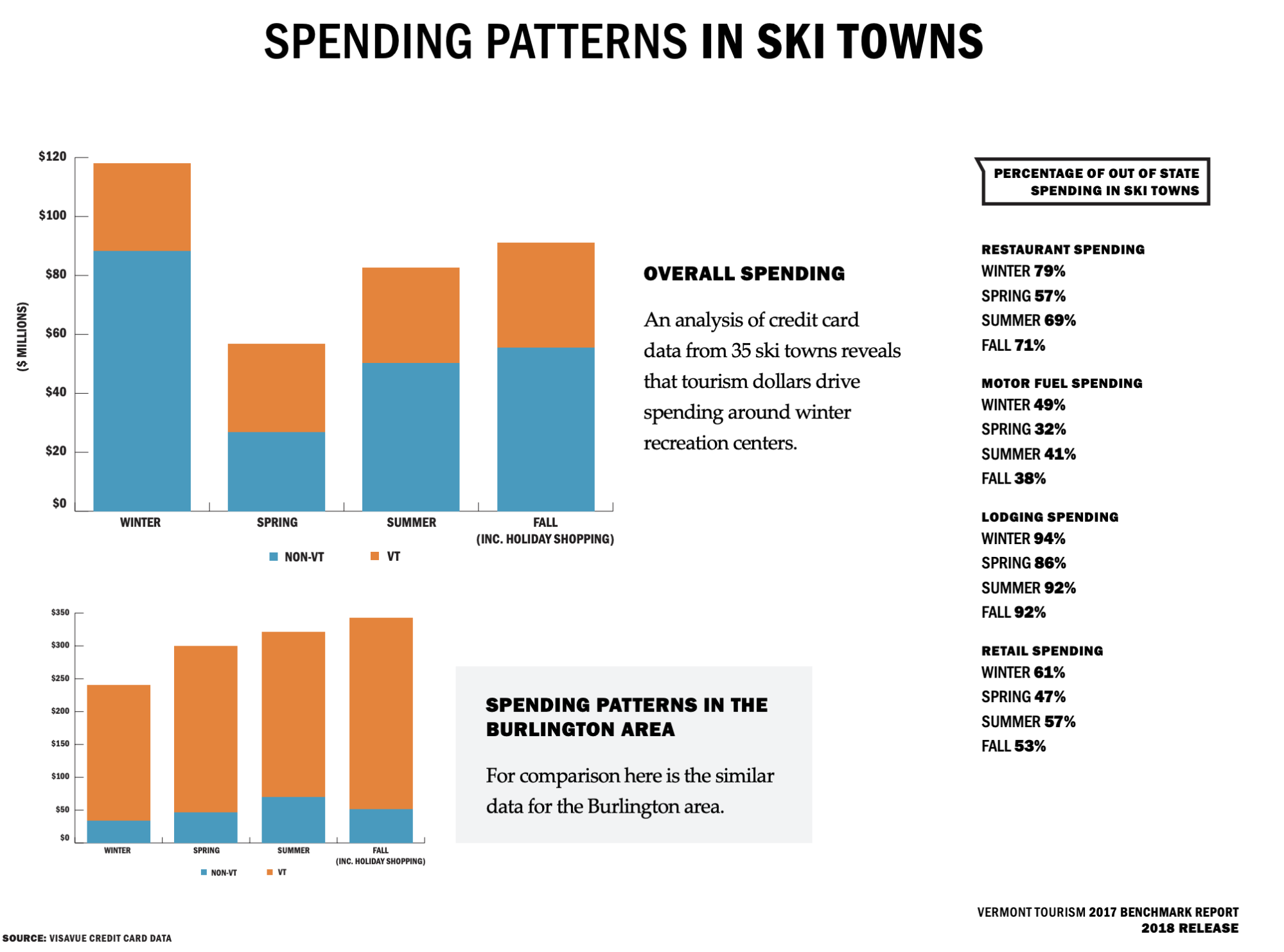
This will likely increase with climate change. The Vermont Department of Forests, Parks and Recreation predicts that as temperatures increase nationally, Vermont will see an increase of Southern-state visitors during the summer. These are visitors looking to escape the hotter months in their region—a form of seasonal climate refuge. These travelers will likely drive an increase in summer tourism and thereby revenue in recreation sectors during typically lower-revenue months of the year (Snyder, personal communication, May 21, 2021).
In addition to the effects of warming temperatures, the COVID-19 pandemic also created an overall uptick in Vermont residents seeking summer recreation. According to the 2020 Vermont Outdoor Recreation Economic Collaborative Report, many recreation locations (trailheads, beaches, campgrounds, etc.) were above capacity for much of the 2020 summer. With an increase in new users accessing these areas, there appeared to be a general lack of knowledge about best practices and ethics that caused higher than average levels of degradation within trail systems, waterways, and on recreating infrastructure. Because of this, the $2 trillion Coronavirus Aid, Relief, and Economic Security (CARES) Act included funding to improve public access to the outdoors. Vermont received $1.6 million which will include upgrades to many fishing and boating access areas; road and trail maintenance at Wildlife Management Areas; as well as a mobile app that will assist the public by educating about outdoor recreation best practices, thereby continuing to make safe places to recreate in Vermont (VOREC, 2020).
The Vermont Department of Forests, Parks and Recreation noted that in order to be more resilient to overuse, Vermont could benefit from a more robust portfolio of accessible state lands, which would in turn provide more diversified opportunities for recreation (Snyder, personal communication, May 21, 2021). An added benefit of this would be a need for recreation staff, creating more jobs for Vermonters. Additionally, creating more recreation-friendly state land would also create opportunities to work in partnership with various government and local non-profit organizations, further bolstering the economy and workforce.
Box 7.3: Impacts of Climate Change on Vermont Mountain Biking
Abby Long, the Executive Director of Kingdom Trails in East Burke, VT, noted that while an extended summer biking season will mean more users and revenue, it also means having to re-allocate budget line items and extend the need for staff. Yet at this phase of climate change it’s still rather unpredictable, which makes it hard for her to make these decisions. She also mentions that extreme drought and catastrophic rain events both have indelible effects on a trail’s health for the foreseeable seasons, and new users may not know trail etiquette designed to maintain healthy and usable trails (Long, personal communication, March 12, 2021). The Vermont Department of Forestry, Parks and Recreation echoed this concern: “With wetter summers overall, our trails are seeing more impact from use over longer periods of time each year and with infrastructure that wasn’t built with that amount of use and water or erosion in mind (Snyder, personal communication, May 21, 2021).”
With longer and hotter summers predicted, farms and growers will have an extended growing season (see Agriculture and Food Systems chapter) and agritourism and beer tourism are likely to see an increase in recreation users because of this. A recent survey conducted by UVM in 2019 and 2020 amongst licensed agritourism farms indicated that over half (59%) of the farms surveyed plan on expanding their agritourism services, and almost half (43%) intend to invest more in buildings or equipment to provide a richer agritourism experience (Chase et al., 2021). Similarly, as of 2019, the state of Vermont had a total of 68 craft breweries, ranking it first in the nation for per capita breweries (Vermontbrewers.com). It is no secret that Vermont’s breweries bring tourists from near and far, often to visit in conjunction with hiking, biking, camping, or other recreation-based trips. Additionally, many of Vermont’s breweries focus on sourcing ingredients locally, making a longer growing season beneficial for sourcing local hops and other farmed elements of beer production.
Box 7.4: Clean Water=Clean Beer!
After the Trump administration’s rollback on EPA protections of the Clean Waters Act, craft brewers across the nation, including many in Vermont, signed a petition imploring the new Biden administration to reverse that action to ensure the nation has access to clean drinking water—and clean ingredients for beer!
Lake Champlain’s 490 square miles of surface and 587 miles of shore, along with Vermont’s numerous ponds, rivers, and streams, make Vermont an ideal water-based recreation oasis. The Vermont Department of Forestry, Parks and Recreation predicts that with the higher summer temperatures due to climate change, more people will pursue water-based recreation at higher rates than in the past (Snyder, personal communication, May 21, 2021). However, the issue of water quality and quantity continues to be a driving concern with stakeholders across the board. With increased air temperature comes increased water temperature, leading to water quality issues—specifically in the form of invasive species and algae blooms (see Water Resources and Fish and Wildlife in Vermont chapters)—often forcing popular beaches to close and creating areas for boaters and water enthusiasts to avoid. The recent COVID-19 pandemic also drove a boost in boat sales in the state, ranging from small watercraft like kayaks, canoes, and stand-up paddleboards to larger, motorized craft. Robert Hensley, the general manager at the new Burlington Harbor Marina, notes that new boaters are on the rise in the Burlington area and with that comes increased boater traffic and often less-informed boaters (Hensley, personal communication, July 3, 2021).
Although hunting and fishing licenses in the state have seen a steady decline since 1980, the desire to be outside and connect with the land during the COVID-19 pandemic saw a drastic bump in the amount of hunting and fishing licenses purchased, reaching levels not seen in decades (VT Fish and Wildlife Performance Based Budget Report, 2020). Prior to the pandemic, in 2019 nearly 72,000 resident anglers were estimated to have fished for almost 1.8 million days, and nearly 37,000 nonresident anglers fished for approximately 369,000 days. Unfortunately, data from the same year shows that stream temperatures continued to increase in July, August and September, threatening the health of rivers and affecting their biodiversity and their fisheries. In an interview, President of the Central Vermont Chapter of Trout Unlimited Chase Whiting mentioned that to help mitigate the effects of climate change on Vermont rivers and streams, the state needs to first work with the Clean Waterways Act to address the amount of pollutants that enter the Vermont waterways through runoff. Secondly, Vermont needs to ensure that there is good riparian health along the banks. He also stressed the need for a plan to remove aging dams, which will reconnect rivers with their flood plains. Aging dams also have the potential to collapse in the event of catastrophic rainfall, causing severe flash-flood potential (Whiting, personal communication, March 14, 2021).
Box 7.5: 2019 Angler Revenue in Vermont
Anglers make a significant contribution to recreation and tourism in Vermont; the bulk of their spending is on food, lodging, and related trip expenses. The economic impact of sport fishing in Vermont was estimated to be $147.1 million in retail sales—providing 2,420 jobs and $16.0 million in state and local tax revenues (2020 Department of Fish and Wildlife Budget Report). However, the increase in air and water temperatures could affect the native fisheries in Vermont, thereby decreasing spending in the decades to come (see Water Resources chapter).
7.5 Shoulder Seasons: Fall and Spring
Fall and spring activities are aggregated here because these are transition seasons in Vermont—not only in terms of temperature variation, but also relative to participation in recreation and tourism activities. What patterns of climate change suggest is that annually, as the winter season becomes shorter, the bordering fall and spring recreation opportunities will increase. Currently, outdoor activities done in fall and spring bring less revenue to Vermont than do summer and winter activities. Whether this will continue to hold true as climate change changes is an issue for further research.
Fall and spring are times when Vermonters and visitors enjoy outdoor recreation such as hiking, camping, fishing, mountain biking, hunting, wildlife viewing and photography. An increase in average temperatures in Vermont has the potential to extend the length of time that people can enjoy these opportunities. Activities such as hunting can bring in revenue through permits and other travel expenses, though participation in hunting has declined in Vermont and elsewhere across the US as the population ages (see Fish and Wildlife in Vermont chapter). The slow nature of the decline in Vermont differs from other places, but hunting opportunities must be coordinated with wildlife management planning for game birds, deer, and moose populations. Fostering hunting as a fall/spring recreation opportunity in Vermont may benefit the state both economically and ecologically.
One of Vermont’s most notable recreation and tourism assets is its trees. Vermont forests and orchards provide opportunities for leaf peeping, apple picking, and a thriving maple syrup industry. The maple syrup industry in particular relies heavily on the health and abundance of sugar maples (Acer saccharum). These trees are an environmentally-sensitive species, and climate changes—especially in the Northeast—have already caused the trees to experience negative growth trends (Oswald et al., 2018). Across the US in 2018, revenues from the maple syrup industry brought in over $182 million, with Vermont as the leader in maple syrup production—producing 1.94 million gallons in 2017 (Vermont Agency of Agriculture, 2019).
Comparing Figure 7-7 to Figure 7-8 shows the changing average open and closing season dates for maple syrup production in the US. In 2013, Vermont’s opening date was March 3 and closing date was April 13. In 2021, Vermont’s opening date was March 12 and closing date was April 5. Though variable over the years, this shows an average loss of 16 days in the maple syrup production season.
| Maple Syrup: Average Open and Close Season Date – States and United States, 2011 – 2013 | ||||||
|---|---|---|---|---|---|---|
| State | Season Opened1 | Season Closed2 | ||||
| 2011 | 2012 | 2013 | 2011 | 2012 | 2013 | |
| CT | Feb 24 | Feb 9 | Feb 12 | Mar 28 | Mar 12 | Mar 25 |
| ME | Mar 10 | Feb 28 | Mar 4 | Apr 13 | Mar 28 | Apr 12 |
| MA | Mar 4 | Feb 19 | Feb 26 | Apr 4 | Mar 14 | Apr 3 |
| MI | Mar 8 | Feb 26 | Mar 9 | Apr 6 | Mar 15 | Apr 10 |
| NH | Mar 7 | Feb 24 | Feb 28 | Apr 8 | Mar 20 | Apr 7 |
| NY | Mar 5 | Feb 21 | Feb 27 | Apr 7 | Mar 16 | Apr 9 |
| OH | Feb 24 | Feb 15 | Feb 20 | Mar 27 | Mar 12 | Mar 29 |
| PA | Feb 26 | Feb 16 | Feb 26 | Mar 31 | Mar 13 | Apr 5 |
| VT | Mar 9 | Feb 25 | Mar 3 | Apr 14 | Mar 22 | Apr 13 |
| WI | Mar 15 | Mar 8 | Mar 25 | Apr 12 | Mar 18 | Apr 23 |
| Maple Syrup Average Open and Locse Season Dates – States and United States: 2019-2021 | ||||||
|---|---|---|---|---|---|---|
| State | Season Opened1 | Season Closed2 | ||||
| 2019 | 2020 | 2021 | 2019 | 2020 | 2021 | |
| Maine | Mar 14 | Feb 29 | Mar 6 | Apr 14 | Apr 8 | Apr 6 |
| Michigan | Mar 13 | Mar 1 | Mar 2 | Apr 7 | Mar 30 | Mar 28 |
| New Hampshire | Mar 10 | Feb 24 | Mar 6 | Apr 10 | Mar 30 | Apr 1 |
| New York | Mar 6 | Feb 19 | Mar 4 | Apr 7 | Mar 28 | Apr 2 |
| Pennsylvania | Feb 25 | Feb 18 | Feb 27 | Apr 1 | Mar 20 | Mar 24 |
| Vermont | Mar 12 | Feb 28 | Mar 8 | Apr 15 | Apr 6 | Apr 5 |
| Wisconsin | Mar 21 | Mar 7 | Mar 6 | Apr 14 | Apr 4 | Mar 31 |
| United States | (NA) | (NA) | (NA) | (NA) | (NA) | (NA) |
Vermont was down 21% in maple syrup production in 2021 (USDA NASS, 2021). The health of trees is crucial for syrup production and quality and is important to support an upward trend of maple syrup in Vermont. A shortened maple syrup season can mean a loss in production time and the amount that Vermont is able to produce.
Vermont trees also provide a huge tourism draw based on their autumn beauty. With warmer temperatures, the shift from bright green leaves to the vibrant colors of autumn will be delayed. Currently, most Vermont tourists come from the North/Northeast, with 21% coming from Massachusetts, 17% coming from NY, 9% coming from Connecticut, and 7% each from New Hampshire and New Jersey (Vermont Agency of Commerce and Community Development, 2020). Climate change might reduce the number of visitors if the leaf peeping time shortens or if the colors are more muted and less desirable. Drought years may lead to earlier changes in color and tend towards more browns over the flashier yellows and reds.
Apple picking in the fall is an opportunity for friends and family to spend quality time together in Vermont’s orchards. Apple tree species require cool winters for productive growth and fruit production. The warming temperatures consistent with climate change may cause some of these species to expand into more northern territories (State of Vermont, 2021). The reduction in colder months, though, may affect soil health and thus threaten the productivity of apple tree species. Apples may face new challenges from diseases related to spring precipitation while the trees are in bloom, potentially creating lower grade fruits due to scabbing or damaging whole trees (see Agriculture and Food Systems chapter).
Other factors, though, may accompany longer shoulder seasons (and summer). Ticks and seasonal pests will be a factor as climate becomes increasingly habitable for them (see Human Health chapter). When temperatures are below freezing, tick populations decline; however, with warmer overall temperatures and an increased number of days with average temperatures above freezing, tick populations will increase (Vermont Department of Health, 2018). Warmer temperatures especially increase the abundance of black-legged ticks which expand their territories northward and survive through warmer winter seasons. Increases in tick borne illnesses, like Lyme disease and Anaplasmosis, are likely to occur due to a higher density of ticks in Vermont (Vermont Department of Health, 2018). Lyme disease is the most common tick-borne illness and in 2017, Vermont reported the highest number of probable cases in the U.S. There is an increased risk for tick bites in wooded areas and areas with tall grass and brush. These consequences may impact recreationists involved in outdoor activities such as hiking, camping, and mountain biking (Vermont Department of Health, 2018). Vermont has already seen an increase in Lyme disease cases over the recent years (Figure 7-8 shows probable and confirmed cases from 2005-2018).
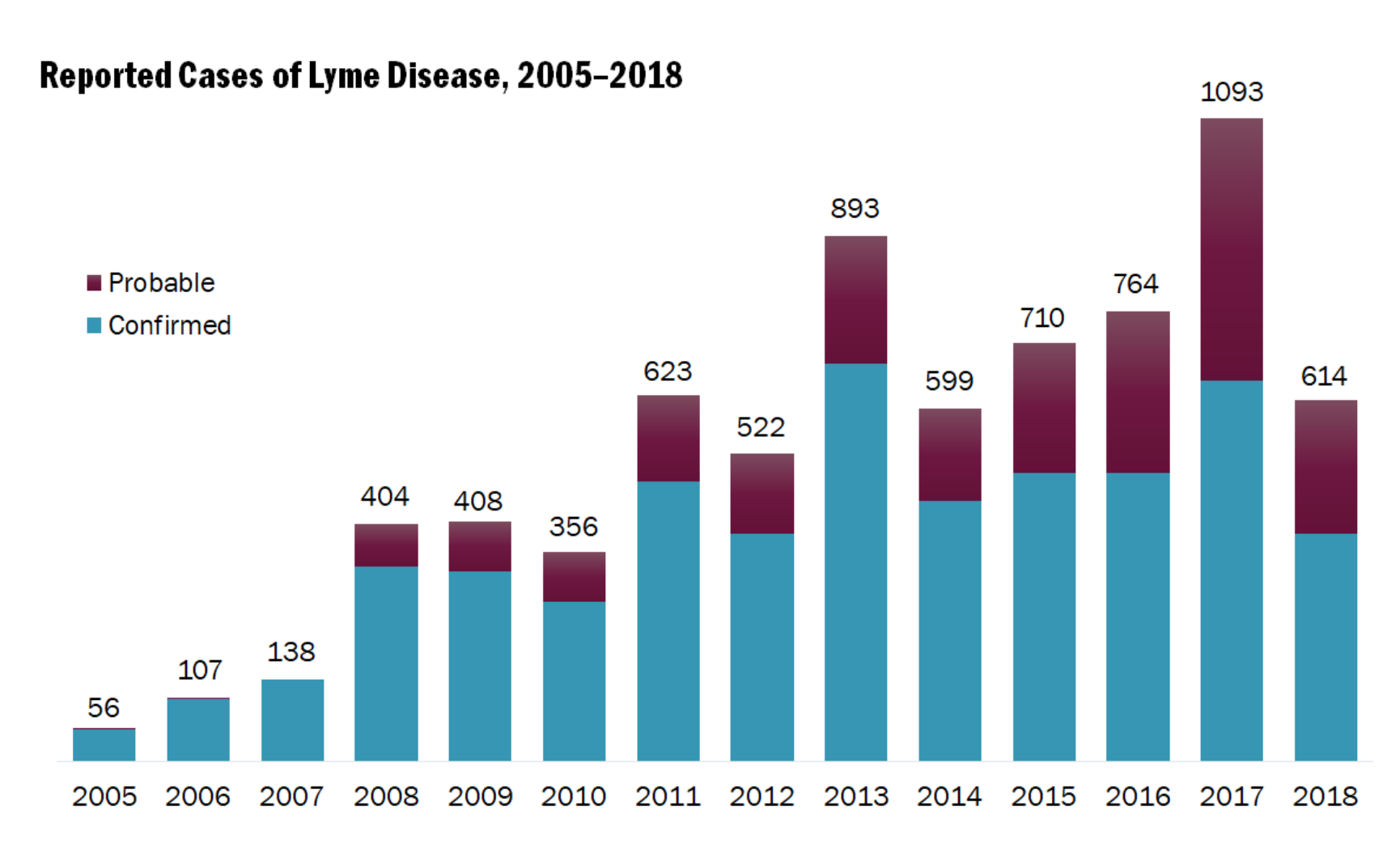
Shoulder seasons provide opportunities for lower-cost recreation opportunities. A warming climate allows activities that involve public spaces and minimal equipment, such as recreational birding and wildlife photography, two activities that are growing in participation nationally and can increase inclusion of many different demographics. Recreational birding is readily available through Vermont wildlife refuges, Audubon Vermont, and local interest groups. The 100-mile long Lake Champlain Birding Trail currently offers views of over 380 different species of birds and the state has over 4 million acres of important bird conservation areas (see Audubon Vermont at https://vt.audubon.org/). Along with birds, wildlife watching and photography are rising in popularity throughout the country (U.S. Fish and Wildlife Service, 2016). Wildlife photography is a relatively low-cost recreation opportunity that provides not only exciting on-site experiences, but like many recreation activities, memories that last a lifetime.
Overall, climate change in Vermont has the opportunity to lengthen shoulder seasons and provide a wider range of activities for recreationists to enjoy in warmer weather. The warmer weather also provides challenges, as it has major effects on Vermont’s trees as well as its pest population, which has implications for recreation endeavors.
7.6 Conclusions
Climate change in Vermont will present distinct challenges and opportunities for the tourism and recreation industry. Currently, winter brings in the most money for the state with the prices and involvement costs of the ski industry. Downhill skiing will be available for recreationists for most of the twenty-first century, but Vermont will need to shift focus to the other seasons as the climate continues to warm. Other winter sports, such as Nordic skiing and snowmobiling, are more vulnerable to climate change and will probably be highly impacted by the changing climate. Pond hockey and skating outdoors on ponds will also face extreme challenges in the coming decades as ice-out dates occur earlier and ice thickness varies. As climate warms and the winter season inevitably gets shorter, the state needs to look for other ways to bring in revenue for warmer seasons.
Participation in warm-weather activities, such as water sports, hiking, mountain and road biking, and fishing will likely increase with warming temperatures and lengthened shoulder seasons. Increased use will require managers of warm weather recreation sites to be mindful of their resources and educate visitors with best-use practices in order to prevent trail erosion and water pollution. One promising aspect of recreation in the face of climate change would be the relative ease of summer sports. Less expensive gear is typically needed for summer recreational activities. Going for a hike in a state park is a cost-effective alternative to more expensive pursuits. Many summer outdoor recreation areas in Vermont do not charge for access, so anyone with means of transportation could visit. If Vermont continues to experience warming trends, the extended warm weather season bodes well for people of any financial background looking to spend time outside in our state. Managers of winter recreation sites, however, will need to continue to find creative ways to make money during the warmer months. Alternative forms of tourism and recreation, such as mountain biking, guided hiking tours, music festivals, and food and beverage events may offset some of the money lost from a shorter winter season; many of these solutions have been implemented by Vermont resorts in the past. Agritourism as well as other forms of food and beverage-related tourism also offer opportunities for Vermont to increase summer revenue, as Vermont continues to make a name for itself in the gastronomy world.
According to the State of Vermont Agency of Commerce and Community Development, Vermont receives over 13 million visitors each year. Many of these visitors participate in some sort of recreational activity during their stay in our state. Community leaders, business owners, and public land managers need to adapt to climate change swiftly and creatively for Vermont to continue to be a hub for recreationists across the globe.
7.7 Acknowledgements
We would like to thank Patricia Stokowski and David Kaufman for providing us with helpful feedback and guidance throughout our writing process. Additionally, we would like to thank the rest of our collaborators on the VCA, and Gillian Galford and Stephen Posner for aiding us in completing our chapter. We would also like to thank Tim Reiter, Chase Whiting, Abby Long, and the Staff in the Commissioner of Forests, Parks, and Recreation Michael Snyder’s office.
7.8 References
Abegg, B., Morin, S., Demiroglu, O. C., François, H., Rothleitner, M., & Strasser, U. (2020). Overloaded! Critical revision and a new conceptual approach for snow indicators in ski tourism. International Journal of Biometeorology, 1-11.
Bowker, J. M., & Askew, A. (2012). US outdoor recreation participation projections to 2060. In: Cordell, HK ed. 2012. Outdoor Recreation Trends and Futures: A technical document supporting the Forest Service 2010 Resources Planning Act Assessment. Gen. Tech. Rep. SRS-150. Asheville, NC: US Department of Agriculture Forest Service, Southern Research Station. 105-124., 150, 105-124.
Bürki, R. (2000). Klimaänderung und Anpassungsprozesse im Wintertourismus (Vol. 6). Ostschweizerische Geographische Gesellschaft. Page 42.
Campbell, J. L., Ollinger, S. V., Flerchinger, G. N., Wicklein, H., Hayhoe, K., & Bailey, A. S. (2010). Past and projected future changes in snowpack and soil frost at the Hubbard Brook Experimental Forest, New Hampshire, USA. Hydrological Processes, 24(17), 2465-2
Chase, L., Wang W., Bartlett R., Conner D., Quella L., & Hollas C. (April 2021). Agritourism and On-Farm Direct Sales Survey: Results for Vermont. University of Vermont. https://www.uvm.edu/sites/default/files/Vermont-Agritourism-Collaborative/VT_Survey_Report.pdf
Fairley, S., Ruhanen, L., Lovegrove, H. (2015). On frozen ponds: The impact of climate change on hosting pond hockey tournaments. Sport Management Review. 18 (2015) 618–626.
Hamilton, L. C., Brown, C., & Keim, B. D. (2007). Ski areas, weather and climate: time series models for New England case studies. International Journal of Climatology: A Journal of the Royal Meteorological Society, 27(15), 2113-2124.
Hensley, R. (2021). Personal Communication. 03 July 2021.
Hodgkins, G. A., James, I. C., & Huntington, T. G. (2002). Historical changes in lake ice‐out dates as indicators of climate change in New England, 1850–2000. International Journal of Climatology: A Journal of the Royal Meteorological Society, 22(15), 1819-1827.
Jones, K. (2018). 2017 Benchmark Report, Tourism in Vermont. Vermont Department of Tourism and Marketing.
Landry, C. E., Bergstrom, J., Salazar, J., & Turner, D. (2021). How Has the COVID‐19 Pandemic Affected Outdoor Recreation in the US? A Revealed Preference Approach. Applied Economic Perspectives and Policy, 43(1), 443-457.
Long, A. (2021). Personal Communication. 13 March 2021.
Oswald, E. M., Pontius, J., Rayback, S. A., Schaberg, P. G., Wilmot, S. H., & Dupigny-Giroux, L. A. (2018). The complex relationship between climate and sugar maple health: Climate change implications in Vermont for a key northern hardwood species. Forest Ecologand Management, 422, 303-312.
Perry, E., Manning, R., Xiao, X., Valliere, W., & Reigner, N. (2018). Social Climate Change: The Advancing Extirpation of Snowmobilers in Vermont. Journal of Park & Recreation Administration, 36(2).
Scott, D., Dawson, J., & Jones, B. (2008). Climate change vulnerability of the US Northeast winter recreation–tourism sector. Mitigation and adaptation strategies for global change, 13(5), 577-596.
Scott, D., Steiger, R., Knowles, N., & Fang, Y. (2020). Regional ski tourism risk to climate change: An inter-comparison of Eastern Canada and US Northeast markets, Journal of Sustainable Tourism, 28(4), 568-586
Shanley, J. B., & Wemple, B. (2001). Water quantity and quality in the mountain environment. Vt. L. Rev., 26, 717.
Snyder, M. (2021). Personal Communication. 21 May 2021.
State of Vermont. (2021). Climate Change in Vermont. https://climatechange.vermont.gov/our-changing-climate/what-it-means/farms-forests
Steiger & Abegg. (2013). The Sensitivity of Austrian Ski Areas to Climate Change. Tourism Planning & Development. 10:4, 480-493.
Steiger, R., Scott, D., Abegg, B., Pons, M., & Aall, C. (2019). A critical review of climatchange risk for ski tourism. Current Issues in Tourism, 22(11), 1343-1379.
State of Vermont Agency of Commerce and Community Development. (2021). Tourism and Marketing. https://accd.vermont.gov/tourism
US Census Bureau. (2019). https://www.census.gov/quickfacts/fact/table/VT/RHI125219
United States Department of Agriculture: National Agricultural Statistics Service. (2013). https://www.uvm.edu/sites/default/files/Agriculture/maple-nass-2013.pdf
United States Department of Agriculture: National Agricultural Statistics Service. (2019). https://www.nass.usda.gov/Statistics_by_State/Pennsylvania/Publications/Survey_Results/2019/Maple%20Syrup%202019.pdf
United States Department of Agriculture: National Agricultural Statistics Service. (2021).https://www.nass.usda.gov/Statistics_by_State/New_England_includes/Publications/Current_News_Release/2021/Vermont%202021%20Maple%20Production.pdf
U.S. Geological Survey (2021). USGS Current Water Data for Vermont. National Water Information System. Accessed online 06/06/21 at https://waterdata.usgs.gov/vt/nwis/rt.
Vermont Agency of Commerce and Community Development. (2020) .https://accd.vermont.gov/tourism/research
Vermont Agency of Natural Resources. (1996). Environmental Protection Rules Chapter 16 Water Withdrawals for Snowmaking
Vermont Brewers Association (2019). https://www.vermontbrewers.com/about/economic-impact.
Vermont Department of Fish and Wildlife (2020). Performance-Based Budget 2020 Report. https://vtfishandwildlife.com/sites/fishandwildlife/files/documents/About%20Us/Budget%20and%20Planning/VT-Fish-Wildlife-2020-Performance-Based-Report.pdf.
Vermont Department of Fish and Wildlife (2016). National Service of Fishing, Hunting, and Wildlife- Associated Recreation. https://www.fws.gov/wsfrprograms/Subpages/NationalSurvey/nat_survey2016.pdf
Vermont Department of Forests, Parks and Recreation. (2020). 2020 Annual Report to the Governor, Vermont Outdoor Recreation Economic Collaborative. https://fpr.vermont.gov/sites/fpr/files/2020%20VOREC%20Report%20and%20Recommendations.pdf.
Vermont Department of Health. (2018). Climate Change, Lyme Disease, and Other Tick Borne Diseases in Vermonthttps://www.healthvermont.gov/disease-control/tickborne-diseases/lyme-disease
Vermont Department of Tourism and Marketing. (2018). 2017 Benchmark Report, Tourism in Vermont. https://accd.vermont.gov/sites/accdnew/files/documents/VDTM/BenchmarkStudy/VDTM-Research-2017BenchmarkStudyExecutiveSummary.pdf.
Weiss, H. S. (2021). The Feasibility of Over-Summer Snow Storage at the Craftsbury Outdoor Center, Craftsbury VT. Graduate College Dissertations and Theses. 1345. https://scholarworks.uvm.edu/graddis/1345
Whiting, C. (2021). Personal Communication. 14 March 2021.
